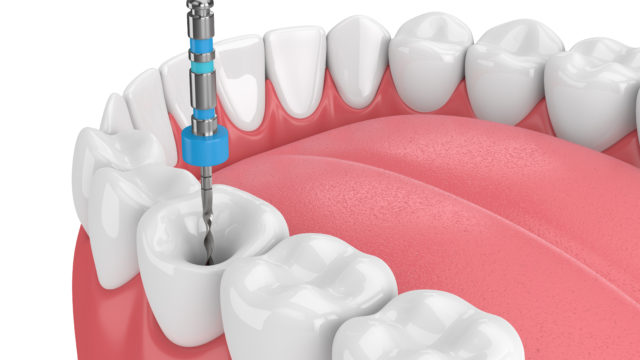Many people cringe at the thought of having a root canal. The truth is, sometimes a root canal is the only option for saving a tooth and resolving pain. Unfortunately, root canals have been stereotyped as a horrifying experience, but you might be surprised to learn they aren’t as bad as they sound.
Do I need a root canal? Do root canals hurt? What should I not do before a root canal? We’ve got the answers to all of your questions about root canals, why you might need one, and what you can expect at the dentist.
What is a Root Canal?
Root canal therapy, also known as endodontic therapy, is the only way to treat a deep infection in the tooth’s pulp. The procedure involves cleaning out the tooth root canal to remove all decay, bacteria, and infection. Clearing this damaged tissue and then sealing the area can prevent further damage and save the tooth.
General dentists can perform root canal treatments, or they may refer you to somebody who specializes in endodontics.

What are the Disadvantages of Root Canals?
Endodontic treatment is the only way to permanently treat inflamed or infected pulp. However, there are some drawbacks to be aware of before getting a root canal treatment at the dentist.
First, root canal therapy can weaken your tooth and render it too weak to function. That’s why dentists usually add a crown to support the remaining tooth structure. The other drawback is that you may need to go to several appointments if it’s a complicated case with severe damage.
Read more: Everything You Need to Know – But May be Afraid to Ask – About Tooth Extraction
How Do I Know If I Need a Root Canal?
There’s only one way to know for sure that you need a root canal procedure, and that’s to visit your dentist. While you may or may not recognize some of the common symptoms, your dentist is the only person who can make the diagnosis.
Persistent pain
Persistent tooth pain could signal the need for a root canal, or it may be due to other causes, like a cavity or damaged filling.
Tooth sensitivity
Sensitivity to hot and cold temperatures could suggest you need a root canal.
Tooth discoloration
If you notice discoloration, specifically a grayish-black color, see your dentist as soon as possible to have the tooth evaluated.
Swollen gums
Swollen gums, even if intermittent, could suggest an infection in the tooth.
Chipped tooth
A chipped or cracked tooth can trigger damage to the tooth nerves and require a root canal.
Difficulty chewing
Difficulty eating, brushing, or touching your tooth at all could alert you to an infection. If your tooth feels loose, it could be due to problems with the nerves and pulp.
Again, only your dentist can identify the need for a root canal, but the above symptoms signal a reason to make an appointment. See a dentist as soon as possible to avoid more damage to the tooth, surrounding tissues, and adjacent teeth.
How Do I Get Rid of a Tooth Infection Without a Root Canal?
Root canal therapy is the only way to permanently cure a tooth decay infection, unless you are a candidate for an extraction, which removes the infected tooth. You can try natural remedies to ease the pain and discomfort until you see your dentist, but they won’t resolve the underlying issue.
How common is root canal therapy?
Over 41,000 root canal procedures are carried out daily in the United States, as reported by the American Association of Endodontists. So we’re looking at around 15 million root canals performed annually, we’d say pretty common!
Can I Just Get a Filling Instead of a Root Canal?
Unfortunately, a filling won’t treat the infection or prevent further damage. A filling only works for decay on the outer layer of the tooth. If you need a root canal, it means your cavity has grown past the point of repair.
Read more: Tooth Extractions: When Do You Need to Remove a Tooth?
What to Expect With a Root Canal?
Root canals are relatively common procedures that can be performed by your general dentist. Hearing that a root canal is common and performed regularly across the United States may not be enough to ease your mind. Follow this list for a step-by-step guide of the process.
- Your dentist will examine the tooth and take x-rays to assess the extent of the damage.
- Next, they numb the area with a local anesthetic and use endodontic files to clear out the infected area.
- Once the area is all clear, your dentist will flush out the debris.
- If the infection is too severe, the dentist may apply medication to the area and temporarily seal it to ensure the infection resolves before completing the process.
- When the tooth is infection-free and clear of all debris, your dentist will fill the canal and permanently seal the tooth.
- If a tooth is too weak to function properly, your dentist will suggest a crown to support the damaged tooth.
Is a Root Canal Painful?
Root canals earned a bad name several decades ago when the procedure did hurt. However, with modern technology and medical advancements, we have better tools and anesthetics to make root canals a relatively painless process.
Most people experience little to no discomfort with root canal surgery. However, you may have some discomfort for a few days afterward. It should be manageable with over-the-counter pain relievers.
How Long Does a Root Canal Take?
Generally, a root canal takes anywhere from an hour to an hour and a half. If it’s a complicated case, the process may take longer.
Why Do Root Canals Take 2 Visits?
It is possible to get a root canal done in one visit, but it’s more effective to split the treatment into two visits. The first visit would involve cleaning out the debris and infection, applying the medication, and covering the tooth with a temporary seal.
In a week or so, your dentist would have you return for a second appointment to make sure the infection is gone and the area has healed well. They will remove the temporary seal, fill the canal and apply the permanent seal.
What Are the Symptoms of a Failed Root Canal?
Occasionally, complications arising from a root canal are unavoidable. If your tooth is too badly injured, this option will not be available to you. Signs of a failed root canal include:
- Pain.
- Red, puffy, and swollen gums.
- Drainage or pus.
- Discoloration of the teeth.
- Gum boil or pimple.
What if my root canal fails?
If your root canal doesn’t work, you and your dentist will need to discuss your options. It’s possible that root canal retreatment could work in your instance. Other options include an apicoectomy (or surgery at the apex of the tooth) or an extraction of the affected tooth.
Are Root Canals Safe?
A root canal is a safe and effective treatment option for tooth pain. The success rate of this procedure is as high as 98%.
How Should I Prepare for Root Canal Treatment?
You should feel comfortable asking your dentist anything you want to know before they start the root canal. The following are some steps you can take to get ready for your root canal:
If there is a significant infection, your doctor may prescribe antibiotics or anti-inflammatory drugs to take in the days leading up to your consultation. Because they can inhibit the body’s natural healing processes, tobacco products should be avoided at all costs. If you smoke cigarettes, try to cut down or quit completely in the days leading up to your root canal procedure.
Root Canal Aftercare
Advice on how to maintain good dental health will be provided by the dentist. You only need to use a soft-bristled toothbrush and brush the area twice daily to keep it clean.
It is essential to remember to refrain from eating harder, solid foods until the tooth has healed. Limiting sugary and acidic food and drink intake can help prevent cavities and reinfection. Regular dental cleanings are important for maintaining the health of a restored tooth and the teeth around it.
How Long Does it Take to Recover from a Root Canal?
Getting back to normal after a root canal usually takes only a few days. It is normal for a patient to experience some discomfort in the first 24-48 hours after surgery. Your dentist can recommend an over-the-counter pain reliever to help with the discomfort. In addition, a cold compress helps alleviate these symptoms and may speed up the healing process. Brushing and flossing your teeth twice a day should still be part of your normal routine, even while you’re healing. Until the dental crown or filling has been bonded into place, you should avoid biting down too hard on the treated tooth.
What Factors Affect the Length of the Root Canal Procedure?
The time it takes to complete a root canal procedure can be affected by a number of factors.
- Its root-canal-infection-severity
- Where in the mouth the afflicted tooth is situated
- Whether a crown or permanent filling is needed for the tooth in the future
Can I Get a Root Canal Without a Crown?
Yes, it’s possible that the dental filler and seal will be sufficient. However, if the tooth is too weak it may need a crown for support. Additionally, if the tooth is discolored then a crown offers a cosmetic fix.
What’s the Difference Between a Molar Root Canal and a Root Canal on a Front Tooth?
Many people are familiar with molar root canals, but the process for a root canal on a front tooth is even easier. While your dentist would follow the same procedure as with a molar root canal and crown, the front tooth is easier to access since it’s at the front of your mouth, and there is less pulp involved. Recovery time should be faster with a front tooth as well.
How Much Does a Root Canal Cost?
Root canal treatment costs vary depending on the tooth’s location, how much work is necessary, and whether or not it needs a crown. That said, the average cost of a root canal is between $500 and $1700. A root canal and crown cost more, depending on the type of crown you need.
What Happens if I Can’t Afford a Root Canal?
Delaying a root canal for too long can cause several problems; the infection can spread and put you at risk for other complications. If you cannot afford a root canal at a dentist near you, Jefferson Dental & Orthodontics may be able to help. We offer flexible financing options and a Dental Savings Plan that could make the root canal more affordable for you.




